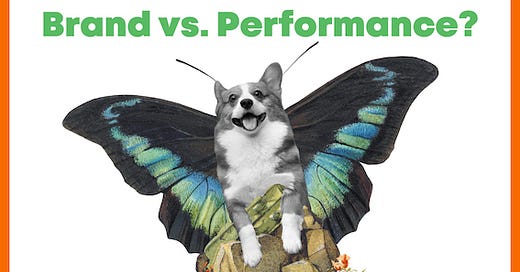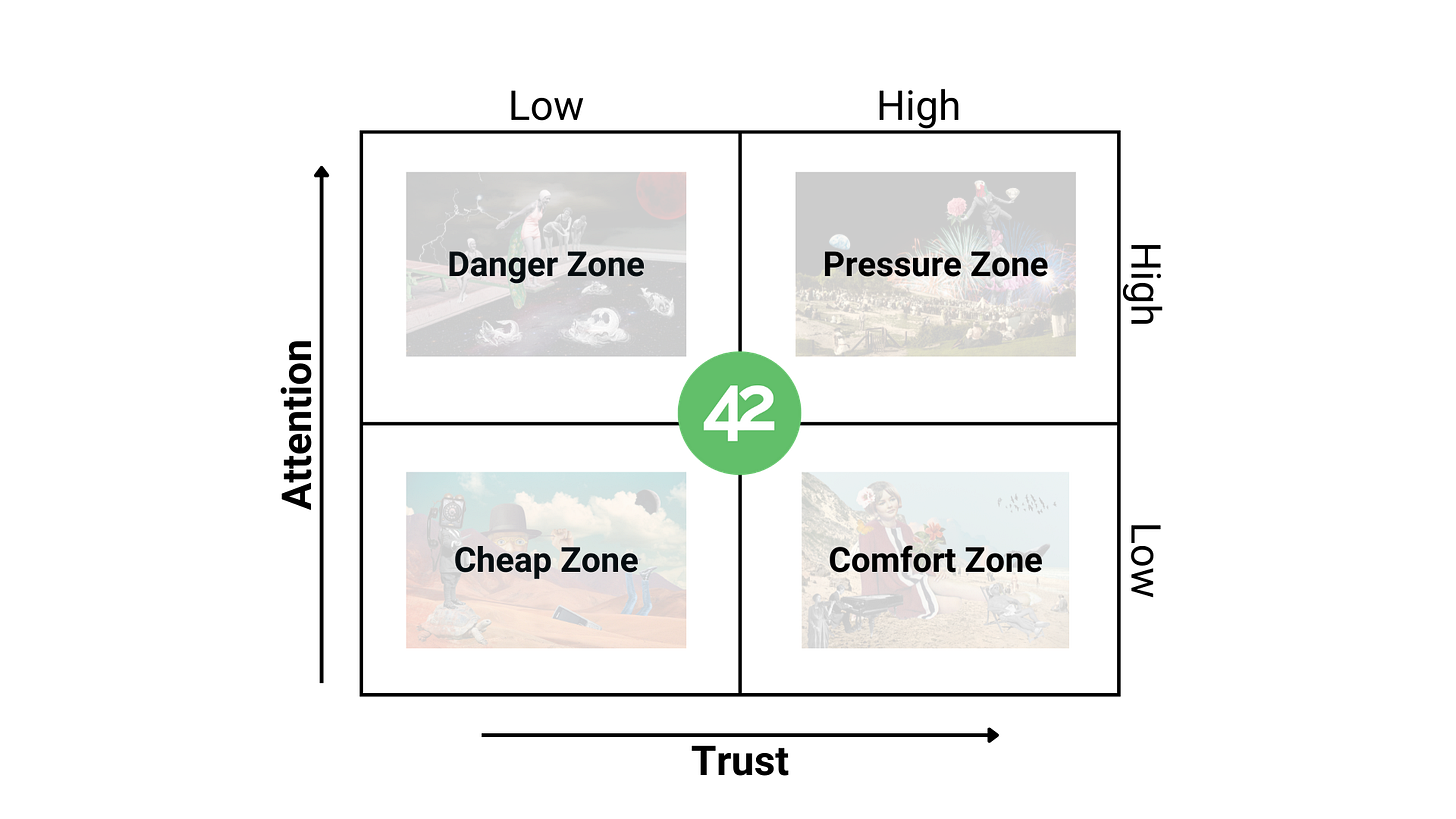The Trust and Attention Framework
Moving beyond brand & performance - introducing a new framework
Editors Note: What is more important? Brand or the direct response? It depends on who you ask - but one thing is for sure. It's a hot-button topic. The key, in our view, is to look at it holistically. Without a strong brand - you don't have an audience. Without the sales, you don't have revenue. But what if we take it a step further & break it down more? It boils down to - building trust & grabbing attention.
I talked about the concept of time horizons on the podcast with Eric Stockton (VP Demand Gen @ SharpSpring / Constant Contact). If your time horizon is 6-12 months / you need to drive revenue now & you'll focus more on the short-term direct response marketing. If your time horizon is 24 mo - you have the space to build a brand & simply let people know you exist without having them take action.
Salesforce can run an ad about Team Earth at the Super Bowl (and hire a Hollywood mega star) because they are the market leaders & they have enough of a brand in the CRM & B2B Software space to build goodwill via aspirational messages. For a "Series A" startup struggling to find customers - this scenario probably will not work. This is a similar idea to what we discussed in our Media vs. Content essay.
You have to ''earn'' the right to build a brand in some ways. More so in the personal brand space where every Ali Mohammad & Irfan writes Twitter threads that are recycled Twitter threads that don't reflect actual knowledge or expertise. I am writing these opinions now because (in some ways) after working in B2B marketing for the past decade+ I have some strong opinions on how it should be done. I talk about personal branding & more in this great chat with Phil & Jon on the wonderful Humans of MarTech podcast.
Note: Before you read this article it might be good to start with our Brand vs. Performance piece right here. To be fair, the ideas and framework you will find below emerged due to how inaccurate it is to separate marketing modalities (brand, product, performance) to push growth.
In a hyper-connected economy that saturates us with stimuli and ads across screens, "proper" marketing is more than a brand vs. product vs. performance decision. We have many things to pay attention to, and it is more challenging than ever to stand out.
According to Seth Godin:
"The two scarce elements of our economy are trust and attention.
As we mentioned in previous essays - as marketers we need to learn to think in bets and experiment. There are no absolute answers, no playbooks, no rules, no guidelines. What we have instead as an ever changing crowded market and a consumer with infinite problems and limited attention. Our job is to connect our product or service with that particular problem the user is looking to solve at the right price point with at least friction as possible.
So when we think about marketers getting hooked on a single modality of marketing, we know something is off.
Here, we will discuss a different way to think about marketing as a whole. A different lens that we think helps marketers better understand what needs to get done to market products and close sales.
This is an attempt to understand and dissect marketing campaigns without falling into the demand vs. product vs. brand trap. But, keep in mind that it is not the ultimate answer nor the framework you should adopt for your marketing campaigns unless it makes sense to you and your organization.
But first, let's dissect a campaign that we think crushed it.
Coinbase and the Superbowl
You are watching one of the most important sporting events of all time, and suddenly a weird QR code that looks just like that awesome The Office episode starts bouncing on screen. What do you do, probably scan it right?
That is exactly what Coinbase did. At the right moment, with the right format.
Had they done that three years ago, no one would have scanned the code (it was not part of our daily habits until the pandemic had us scanning QR codes everywhere). Had they done another traditional Superbowl ad, they probably would not have created such a powerful brand play - nor would it have been possible to get so many downloads (their site actually crashed).
Massive win. And yet, it only took a couple of days for them to ruin the trust gained by claiming the idea was born in-house (when apparently, it was not).
Sure, this is still a fantastic marketing and sales exercise, and probably many of the newly acquired users will never even learn about the idea of not being born in-house (nor would they care). Coinbase won. And the reason behind it is that the ad got millions of eyeballs, QR scans, and trust-building mental associations.
Cryptocurrencies are still a mystery for many of us. We do not understand what they are, how to use them, or why they even hold value (not like we understand fiat currencies either - but that is a discussion for another essay). The Superbowl ad allowed Coinbase to creatively cross the tech adoption chasm, acquire users, gain attention, and build trust in this shady, quite techy, and niche-oriented territory.
Would a fake shady company advertise in the Superbowl? - Obviously not. And so, Coinbase's colossal win is to connect symbolic meaning and trust to their brand while simultaneously capturing attention like never before. In other words, it is a move any well-rounded marketer would be proud of (by combining performance, product, and brand).
But how exactly did they accomplish such a fantastic campaign?
To understand what Coinbase accomplished with this campaign, we have created a framework that tracks trust and attention. We did so because we firmly believe that instead of thinking about the marketing modalities and tactical actions, it makes more sense to think about the product, the category, the people exposed to your marketing campaign, and the trust and attention needed to succeed.
In the case of Coinbase, they indeed had the attention and trust of innovators and early adopters. But convincing the tech adoption majorities and laggards to use Coinbase probably was not as easy. In that context, creating a Superbowl ad that increases the amount of attention they receive from later stages in the tech adoption curve makes a lot of sense and builds a trustworthy brand in a space where trust is an issue (crypto beyond early adopters).
In other words, it allows them to move from a low trust low attention quadrant to a low trust high attention quadrant. And, after having millions of people scanning a QR and experiencing the quality and functionality of the product, hopefully, some of that attention can be translated into using the product, trust and word-of-mouth. Quite a feat considering it is crypto.
It was a brilliant move and perhaps, one of the most creative examples we will see of marketing creativity (floating QR) and performance (QR that drives signups) being orchestrated.
Thinking about this example using an attention/trust framework lets us have more strategic clarity as to why it worked and how you can combine all marketing dimensions to achieve a particular objective. That is why we have decided to dive a little deeper and explain the model.
The Trust-Attention Campaign Model.
Good marketers are aware of the latest playbooks and execute them well. Great marketers know playbooks are useless and use them as the starting point to develop creative and analytical ways to understand their role and how to accomplish the goals required from their marketing campaigns.
Before we continue, a couple of quick notes:
attention is an immediate tactical effort that pushes brands to the top of mind and tip of tongue. Trust is a slow symbolic construct that takes time, effort, and a clear, meaningful code in the consumer's mind. That means that the "attention axis" is volatile, fast, and dynamic, while trust is solid, deep, and complex. It is crucial to consider this because you can build trust by capturing attention. Still, if the attention tactic you use does not resonate with your audience, you can damage your reputation - which, as we mentioned, is a slow and challenging thing to build, and taking risks by being noticed is not always the right thing to do.
This framework is a lot more useful if you understand your brand's positioning within the category, the audience you are trying to reach, and the objective of the campaign. Marketing to an innovator is different from marketing to a laggard. Likewise, if you are the category leader, you may try other strategies than a new competitor. And finally, if you are more worried about metrics to show your investors, perhaps attention-driven tactics make more sense than slow trust-building campaigns.
It all depends, but understanding the balance between trust and attention lets you map creative campaigns that orchestrate performance and brand.It also helps if you know how trusted and how much attention your brand currently captures. Brands are not located or “positioned” in the quadrants of this model, but it is different to run campaigns if many people trust you than if you are new in your category. Your starting point in terms of trust and attention allows you to understand how trusted and recognized your brand is, and how to produce campaigns to move forward.
Having said all of that, let's take a look at each quadrant in depth.
Cheap zone:
This quadrant generally promotes marketing campaigns that focus on small efforts and quick wins. In this area, the product you are trying to market is probably not well-known, nor does it have enough users or interactions to have a solid reputation. This zone is the most common initial scenario for brands positioning a new product in a crowded category and looking to grow their sales.
The cheap zone is where using "quick-wins," "playbooks," and short-term thinking is natural because there is little risk. You are launching the product, and probably the focus rather than increasing your ARR is to fully understand the experience your user has with your product and how to improve it to solve their problems - and hopefully differentiate yourself from your competitors (The PMM modality).
Yet, you may have to drive quick results and show positive metrics. We get it, that is the startup world and the way it works is through positive KPIs. But, keep in mind that churn rates are real and even if your CAC is low and it shows positive metrics your LTV is also fundamental for growth. It is much cheaper to keep a user than to acquire one. And providing a marvelous experience and creating a memorable brand might just be what you need to do beyond quick result-driven campaigns.
This zone is an initial stage that several SaaS will probably face, but it is also a place they should move out of as soon as possible. Having low trust (not enough users to validate your product or talk about it) and low attention (few channels and messages) will probably mean your growth will be slow. And, if we have learned anything from working with startups, speed is crucial for survival.
Another industry that tends to run its marketing campaigns in this quadrant is the telecommunications industry, where most clients are ready to switch providers simply due to pricing. If you ask ten people what they think of their telco provider, they either have nothing to say or hate it. It is no coincidence that terrible customer service leads to a lack of trust and differentiation (all competitors seem to do the same thing, poorly).
Danger zone:
This is a dangerous zone because you capture lots of attention, but your product and category are still not in the high trust area. An excellent example of a campaign in this quadrant Superbowl ad by Coinbase. They created a bold ad that received lots of attention and conversions. It was a risky move given the audience in relation to the tech adoption curve (early and late majority and laggards) and the low trust the overall crypto industry is facing, especially during a bearish season.
This area requires bold moves and creative and symbolic messages that capture attention (a scarce resource) and build and reposition your brand's semiotic representation.
Think of it as the area where inceptions are possible—the moment where you can take advantage of the attention you are capturing to become famous. The challenge is to be creative and different enough to be noticed and deliver an experience with the product that lives up to your manufactured hype.
An example of doing this well is "This is yoga" by LuluLemon. A radically different campaign set them apart from other yoga brands by connecting their product with genuine cultural insight. This campaign worked because LuluLemon matched the attention received with a fantastic and trustworthy experience. In the end, they quickly moved from the danger zone to a comfortable low attention, high trust quadrant. Once they had captured enough attention and built trust, it was time to ease up a little bit in controversial campaigns and deliver a trustworthy experience.
Other campaigns that fall in this quadrant are the infamous "Think Different" Apple campaign, pushing a brand only innovators and early adopters trusted into a more mainstream domain via disruptive attention-seeking messaging.
As you can probably tell, this quadrant seems to work well as long as you have clarity of the insight and cultural/semiotic impact you want to push forward. Creativity, a bold bet, and understanding the proper channels and messaging to deliver your message works quite well.
It is crucial to remember that this is the dangerous quadrant for a reason. If you launch a campaign in this quadrant wrong, you may face the wrath of having lots of attention in a way that does not align with the values required to build trust and connection.
Pressure zone:
The pressure zone is an area that is hard to handle because you escalate attention even though there is already trust associated with your brand. In other words, brands that produce campaigns in this quadrant are usually in the comfort zone and want to increase market share or salience. The next natural step is to create a more visible campaign and capture attention without sacrificing the trust that is already associated with your product.
Sometimes, brands can jump from the cheap zone to the danger zone and later to the pressure zone; however, it is more common to move to the comfort zone after the danger zone. The reason behind it is that you can pull a cheeky campaign once. But still, if you are a smaller brand or if your product is in a saturated category, chances are you will not be able to continue capturing attention in the long run. In other words, even though the campaign you launched increased visibility and trust, it is far more likely for your brand to fall into a comfort zone area than continue being in the eye of the storm.
As we already quoted, attention is a scarce resource. And, the moment brands do something to stand out, competitors are simply going to try to reclaim their place within the category aggressively.
An example of a poorly run pressure zone campaign was Pepsi's infamous Kendall Jenner ad in 2017. It was controversial because it captured lots of attention just by how out of tune it was with the nature of protests and authority. Although Pepsi probably just wanted to build more trust by pushing a controversial message of union (in this case, the police and protestors), they took a risk by moving from the comfort quadrant to the pressure zone as laggards in their category (behind Coke) without genuine insight that resonated with the audience they targeted.
On the other hand, a well-done ad that elevates a brand to the pressure zone is the Salesforce 2022 Superbowl ad. Salesforce is already a category leader and a massive brand for business platforms. Pushing an ad into the Superbowl takes them out of their comfort zone (where they are positioned and lead), and it allows them to reach new audiences beyond their usual users, and simultaneously enables them to sow a powerful message: "Cause the new frontier. It ain't rocket science. It's right here."
Even though it seems weird, almost disconnected from their category and their brand, it does a fantastic job repositioning the brand as the "real" brand connected with businesses and the planet's health. Not only that, but it also manages to make fun of the metaverse and the space race, concepts that are impossible for most of us to envision given our limited human time perception abilities.
Salesforce is already a titan. But, by doing ads like this, it starts to enter the mainstream culture, and it positions itself as the brand that is here, on earth, to build trust, and help businesses. Not a lousy inception.
Comfort zone:
This is where category leaders and emblematic brands gravitate and produce their campaigns. These brands have gone above and beyond to demonstrate to their users that their brand means something and that you cannot go wrong by buying from them. And, most of their campaigns accurately reflect that.
In the tech world, brands such as Microsoft produce campaigns in this quadrant, or SaaS brands such as Hubspot or Salesforce tend to be here. The beauty of being a brand with campaigns in this quadrant is that you are universally accepted. No one will be upset in a large company if you buy Office 365; people will probably embrace it and accept it because the Microsoft brand means something (trust). If, however, you purchase Slack in a corporate environment, you may have to explain to a couple of people why you decided to go for Slack vs. Teams.
In the startup world, Slack dominates because consumers of Slack (including the campaigns) are innovators and early adopters. But, in the corporate world, Microsoft wins because of its reputation and trust and the campaigns they deploy to build upon that.
When your brand is trusted and does not need to capture attention to survive, it means that you have already achieved salience (you are recognized), significance (you are meaningful), and differentiation (you are unique). Therefore, your campaigns can be less aggressive or attention-seeking because you are looking to maintain trust, not build it from scratch.
Chances are if you are a B2B SaaS brand, this is the aspirational zone rather than the actual place where your brand can develop campaigns or position itself. With a few exceptions of tech brands that fully dominate verticals (think Google, Amazon, Facebook), B2B SaaS brands should envision this quadrant as the ideal rather than the real. This is the monopoly quadrant, where brands are healthy, and campaigns seek to maintain psychological and cultural dominance. Your brand almost surpasses your product, to the point you could come up with a different product, and people would still buy it (think Nintendo).
Let's forget about the brand vs. performance question. Honestly, as fellow marketers, it is time we start asking ourselves the real questions:
What does my audience need to learn about my product and buy it, and how do I get there?
How much trust do I need to build for my ICP to buy my product and how do I get there?
Once we know that, we can develop campaigns that match our attention and trust objectives and allow us to align the mechanics/data required to run a successful campaign with the cultural and psychological insight needed to develop a powerful brand.
___
If you enjoyed this post, please consider subscribing and sharing this piece.
Do you have any ideas for future pieces we should write? Let us know your thoughts in the form below











